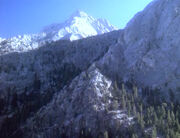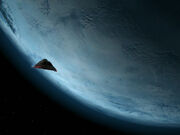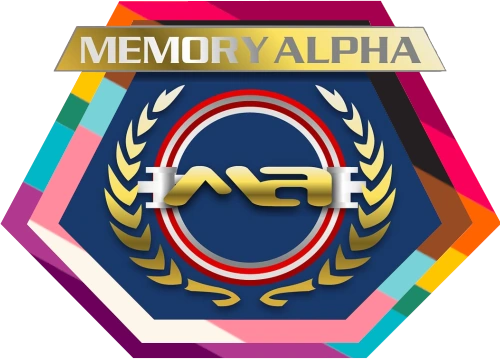
Skalaar's shuttle on the surface of a class L planet

The surface of a class L planet in the Alpha Quadrant

The Delta Flyer orbiting an icy class L planet

The surface of Kelis' homeworld
"It's not much of a sun. And this isn't much of a planet."
In the Federation standard system of planetary classification, some barely habitable planets, planetoids, and moons were classified as class L. Class L worlds could have different kinds of atmospheres ranging from suitable for humanoid life to unsuited without additional means, but typically they had higher concentrations of carbon dioxide than class M worlds. (DS9: "The Sound of Her Voice"; VOY: "Muse") While vegetation was common on L-class worlds, they were usually, though not always, devoid of fauna. (TNG: "The Chase"; DS9: "The Ascent") According to Sylvia Tilly, class L planets were generally considered to have a breathable atmosphere but were environmentally hostile. (DIS: "All Is Possible") Class L planets were prime candidates for colonization and potential terraforming.
In 2153, Skalaar and Jonathan Archer landed on a class L planet with a cloudy atmosphere to escape Kago. The landing site appeared barren and cratered, but allowed them to get out and conduct repairs to the outer hull of Skalaar's shuttle without environmental suits. (ENT: "Bounty")
Indri VIII was a class L planet that lacked animal life but used to be covered with deciduous plants until 2369. That year, the USS Enterprise-D witnessed a Klingon ship destroying the planet's lower atmosphere including all life with a plasma reaction. (TNG: "The Chase")
The USS Olympiacrashed on a class L planet in the Rutharian sector in 2371. The sole survivor was able to survive in a cave on the planet's surface for a while, but died when she ran out of tri-ox injections that prevented carbon dioxide poisoning. (DS9: "The Sound of Her Voice")
Also in 2371, the USS Voyager discovered a colony of Humans on a class L planet in the Delta Quadrant with an oxygen/argonatmosphere. The Humans were abducted by the Briori centuries earlier to be used as slave labor. However, the Human slaves revolted, overthrowing and eradicating their Briori masters. Using their former masters' technology, they established a thriving settlement; by 2371, they had a population of hundreds of thousands across three cities. The planet had steppe-like vegetation and even land that "begged to be farmed." (VOY: "The 37's")
In 2373, Odo and Quark crash-landed the USS Rio Grande on a class L planet after Odo was traveling with Quark to meet a Federation Grand Jury. The crash site was dominated by steep, forested mountains, poisonous vegetation, and lacked animal life. (DS9: "The Ascent")
In an alternate2375, the USS Voyager crash-landed on a class L planet dominated by glaciers near the border of the Alpha Quadrant. This timeline was replaced by a new one when Harry Kim sent a message from fifteen years in the future back to this year. (VOY: "Timeless")
A riddle presented by Neelix to Tuvok in 2376 contained the story of "a lone ensign finds himself stranded on a class L planetoid with no rations. His only possession, a calendar. When Starfleet finds him twelve months later, he's in perfect health. Why didn't he starve to death?" Tuvok suggested that such a planetoid might contain hot water springs. (VOY: "Riddles")
B'Elanna Torres crash-landed the Delta Flyer on a class L planet in 2376 and was stranded there for several days, but Harry Kim finally reached her after walking two hundred kilometers with the part she needed to contact Voyager. The planet was home to a pre-warp civilization and contained at least one body of water while the area around the crash site was mountainous, densely forested, and even hosted some sort of hunting game. (VOY: "Muse")
In 2378, a class L planet was found by OverlookersNar and Zet as a settlement site for the crew of the USS Voyager after they confiscated their warp core. (VOY: "Renaissance Man")
Kokytos, one of Theta Helios' many moons, was a class L world with an icy climate. The moon was prone to spider lightning discharges and was also home to predatory Tuscadian pyrosomes. (DIS: "All Is Possible")
List of class L worlds[]
| Planetary classification |
|---|
| B • D • G • H • J • K • L • M • N • P • R • T • Y • Other classes |
Appendices[]
Background information[]
Kelis' homeworld, as seen in "Muse", appeared somewhat atypical of a class L planet as it contained at least one region that supported lush vegetation and even a pre-warp civilization. Although Harry Kim traversed two hundred kilometers of the planet's surface by foot without any visible life-sustaining equipment, little was seen of the planet's surface and the remainder of the planet might have been far less hospitable and more standard for a class L planet.
According to the Star Trek: Star Charts, on page 25, class L planets were "marginal" planets. They had ages that ranged from four to ten billion years and diameters between 10,000 and 15,000 kilometers. Marginal planets were located within the ecosphere of a star system. They were categorized by a rocky and barren surface with little surface water and an atmosphere of oxygen/argon with a high concentration of carbon dioxide. Native lifeforms were limited to plant life, although the majority of class L planets were suitable for humanoidcolonization.
External link[]
- Class L at Memory Beta, the wiki for licensed Star Trek works







